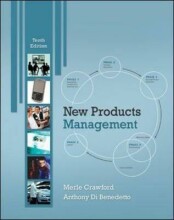Summary: Product Innovation Processes
- This + 400k other summaries
- A unique study and practice tool
- Never study anything twice again
- Get the grades you hope for
- 100% sure, 100% understanding
Read the summary and the most important questions on Product innovation processes
-
2 Lecture 2
-
2.1 Strategic planning for product innovation
This is a preview. There are 4 more flashcards available for chapter 2.1
Show more cards here -
Product innovation strategy:
Provide direction for filling the funnel:- Gap in product portfolio?
- Focus on specific technology, market, trend?
- Develop new product platform?
- Develop new product for existing platform?
-
Product platform planning:
- Technological platforms (shared components)
- Category platforms (shared design or technology)
- Brand platforms (shared brand values)
-
The product innovation charter
Agreeing on focus, goals, and guidelines -
Of what does the PIC consist
- To chart the new product teams' direction (what technologies, what markets)
- To set the teams' goals and objectives (why does the project exist?)
- To tell the teams how they will play the game (what are the constraints? other key information)
-
2.2 Opportunity & Problem Identification
This is a preview. There are 1 more flashcards available for chapter 2.2
Show more cards here -
Three basic types of opportunities:
- Need (why?)
- Form (What?)
- Technology (How?)
-
Importance of customer analysis:
‘The most successful new products match a set of fully understood consumer problems with a cost competitive solution to these problems.’ -
Why customers buy a product:
- Features (What the product consists of)
- Functions (What the product does and how it works)
- Benefits (How the product provides satisfaction to the user)
These match with customers' problems, needs, wants, motivation, values and usage context -
What do we get from customer analysis?
For opportunity or problem identification & analysis:
Identifying problems and needs (What?)
Understanding motivations, values and root causes (Why?)
Understanding the problem / usage context (When and Where?)
Understanding the user characteristics (Who?)
red= constraint, blue= problem/opportunity -
High-level vs. low-level problems
- Leaf problems = consequences (lowest level)
- Central or core problem
- Root problem = causes (highest level)
-
2.3 Customer Analysis Methods
This is a preview. There are 7 more flashcards available for chapter 2.3
Show more cards here -
One-on-one interviews:
- Questioning individuals about product use and problems
- Phone, lab, on the street
Advantages:
Easy in-depth questioning (why?, when?, where?)
Can be informal & inexpensive,
Disadvantages:
but also very expensive & time consuming - Questioning individuals about product use and problems
- Higher grades + faster learning
- Never study anything twice
- 100% sure, 100% understanding
Topics related to Summary: Product Innovation Processes
-
From Opportunity to Concept
-
Ideation & Creativity
-
Concept evaluation and Testing - Concept testing (risk management)
-
Concept evaluation and Testing - Product protocol
-
Creativity and product concept - Product design/ the design of new products
-
Creativity and product concept - Development team management
-
Systematic methods of innovation management - TRIZ levels
-
Managing the marketing launch
-
Managing the technical launch - Learning about product and process - Organizational learning
-
Managing the technical launch - Learning about product and process - Autonomous v.s. induced learning































